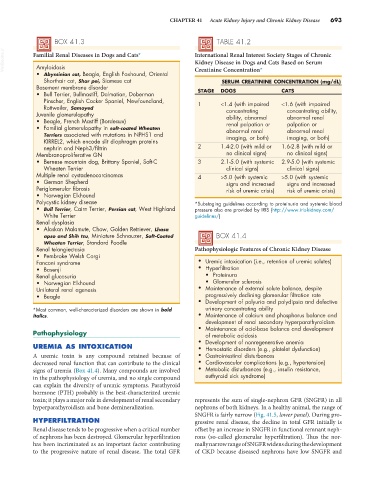Page 721 - Small Animal Internal Medicine, 6th Edition
P. 721
CHAPTER 41 Acute Kidney Injury and Chronic Kidney Disease 693
BOX 41.3 TABLE 41.2
VetBooks.ir Familial Renal Diseases in Dogs and Cats* International Renal Interest Society Stages of Chronic
Kidney Disease in Dogs and Cats Based on Serum
Amyloidosis
• Abyssinian cat, Beagle, English Foxhound, Oriental Creatinine Concentration*
Shorthair cat, Shar pei, Siamese cat SERUM CREATININE CONCENTRATION (mg/dL)
Basement membrane disorder
• Bull Terrier, Bullmastiff, Dalmatian, Doberman STAGE DOGS CATS
Pinscher, English Cocker Spaniel, Newfoundland, 1 <1.4 (with impaired <1.6 (with impaired
Rottweiler, Samoyed concentrating concentrating ability,
Juvenile glomerulopathy ability, abnormal abnormal renal
• Beagle, French Mastiff (Bordeaux) renal palpation or palpation or
• Familial glomerulopathy in soft-coated Wheaten abnormal renal abnormal renal
Terriers associated with mutations in NPHS1 and imaging, or both) imaging, or both)
KIRREL2, which encode slit diaphragm proteins
nephrin and Neph3/filtrin 2 1.4-2.0 (with mild or 1.6-2.8 (with mild or
Membranoproliferative GN no clinical signs) no clinical signs)
• Bernese mountain dog, Brittany Spaniel, Soft-C 3 2.1-5.0 (with systemic 2.9-5.0 (with systemic
Wheaten Terrier clinical signs) clinical signs)
Multiple renal cystadenocarcinomas 4 >5.0 (with systemic >5.0 (with systemic
• German Shepherd signs and increased signs and increased
Periglomerular fibrosis risk of uremic crisis) risk of uremic crisis)
• Norwegian Elkhound
Polycystic kidney disease *Substaging guidelines according to proteinuria and systemic blood
• Bull Terrier, Cairn Terrier, Persian cat, West Highland pressure also are provided by IRIS (http://www.iris-kidney.com/
White Terrier guidelines/)
Renal dysplasia
• Alaskan Malamute, Chow, Golden Retriever, Lhasa
apso and Shih tzu, Miniature Schnauzer, Soft-Coated BOX 41.4
Wheaten Terrier, Standard Poodle
Renal telangiectasia Pathophysiologic Features of Chronic Kidney Disease
• Pembroke Welsh Corgi
Fanconi syndrome • Uremic intoxication (i.e., retention of uremic solutes)
• Basenji • Hyperfiltration
Renal glucosuria • Proteinura
• Norwegian Elkhound • Glomerular sclerosis
Unilateral renal agenesis • Maintenance of external solute balance, despite
• Beagle progressively declining glomerular filtration rate
• Development of polyuria and polydipsia and defective
*Most common, well-characterized disorders are shown in bold urinary concentrating ability
italics. • Maintenance of calcium and phosphorus balance and
development of renal secondary hyperparathyroidism
• Maintenance of acid-base balance and development
Pathophysiology of metabolic acidosis
• Development of nonregenerative anemia
UREMIA AS INTOXICATION • Hemostatic disorders (e.g., platelet dysfunction)
A uremic toxin is any compound retained because of • Gastrointestinal disturbances
decreased renal function that can contribute to the clinical • Cardiovascular complications (e.g., hypertension)
signs of uremia (Box 41.4). Many compounds are involved • Metabolic disturbances (e.g., insulin resistance,
in the pathophysiology of uremia, and no single compound euthyroid sick syndrome)
can explain the diversity of uremic symptoms. Parathyroid
hormone (PTH) probably is the best-characterized uremic
toxin; it plays a major role in development of renal secondary represents the sum of single-nephron GFR (SNGFR) in all
hyperparathyroidism and bone demineralization. nephrons of both kidneys. In a healthy animal, the range of
SNGFR is fairly narrow (Fig. 41.5, lower panel). During pro-
HYPERFILTRATION gressive renal disease, the decline in total GFR initially is
Renal disease tends to be progressive when a critical number offset by an increase in SNGFR in functional remnant neph-
of nephrons has been destroyed. Glomerular hyperfiltration rons (so-called glomerular hyperfiltration). Thus the nor-
has been incriminated as an important factor contributing mally narrow range of SNGFR widens during the development
to the progressive nature of renal disease. The total GFR of CKD because diseased nephrons have low SNGFR and

